It’s a Small Machete Pretending to be a Bowie Knife
There are a lot of things about the way the Battle Bowie looks that gave me pause. It has a little too much of that sword-at-a-flea-market styling for me to really expect much. The extreme curve of the handle and the way the blade basically has a cutlass shape just make the whole thing look like a movie replica.
My opinion has changed significantly, and there’s a graveyard of halved tree branches somewhere up a creek to explain why. What I thought would be a short but intense afternoon of testing where I basically chopped random things until something broke turned into more fun than I’ve had with a knife in a long time, and that’s saying a lot.
Turns out the dramatic styling of the blade and handle actually make it good at most of the things you would imagine doing with it.
Specifications
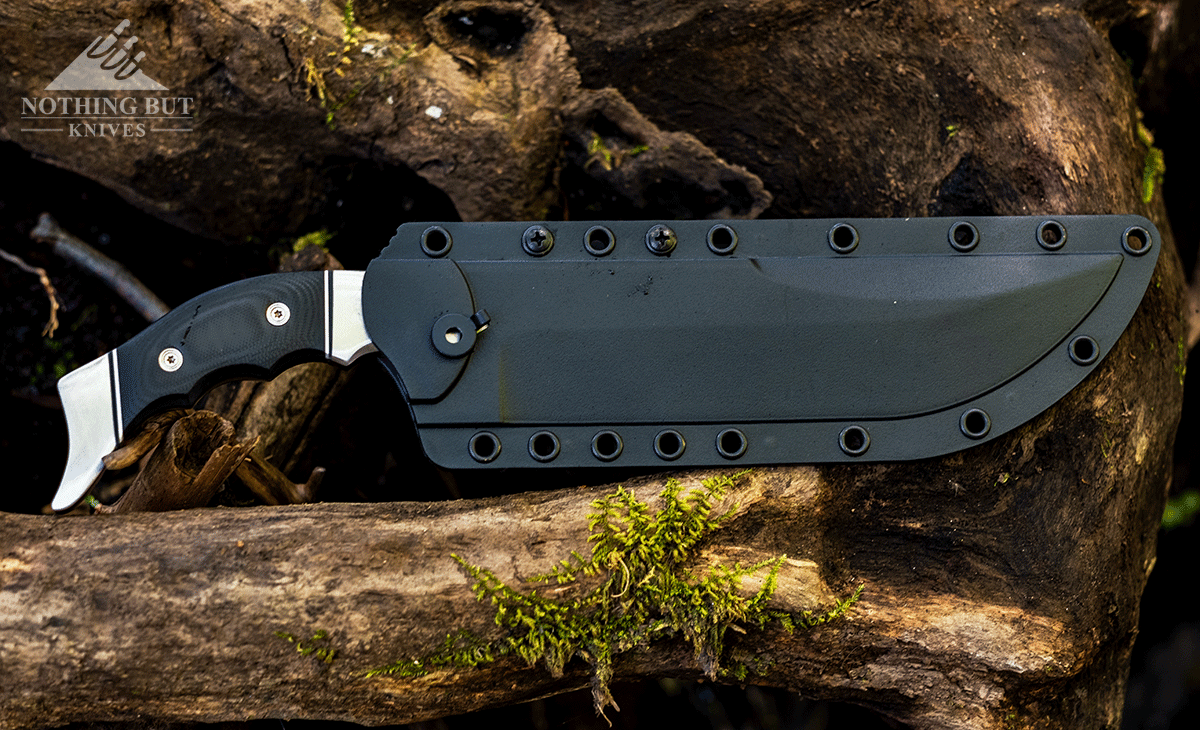
| Overall Length: | 13.375″ |
| Blade Length: | 8.0″ |
| Blade Steel: | 440 or 8Cr13MoV |
| Blade Grind: | Hollow |
| Blade Style: | Clip point |
| Blade Thickness: | 0.18″ |
| Handle Length: | 5.375″ |
| Handle Material: | G-10 w/ stainless steel guard and pommel |
| Weight: | 13.44 oz |
| Sheath: | Blade-Tech molded polymer with Tek-Lok |
| Designer: | Russ Kommer |
Pros
| Comes with a Tek-Lok |
| Good balance |
| Good edge and grind |
| Chops and slices well |
Cons
| Useless choil |
| Thin handle |
| Handle material isn’t textured |
Let’s Get This Tactical Nonsense Out of the Way
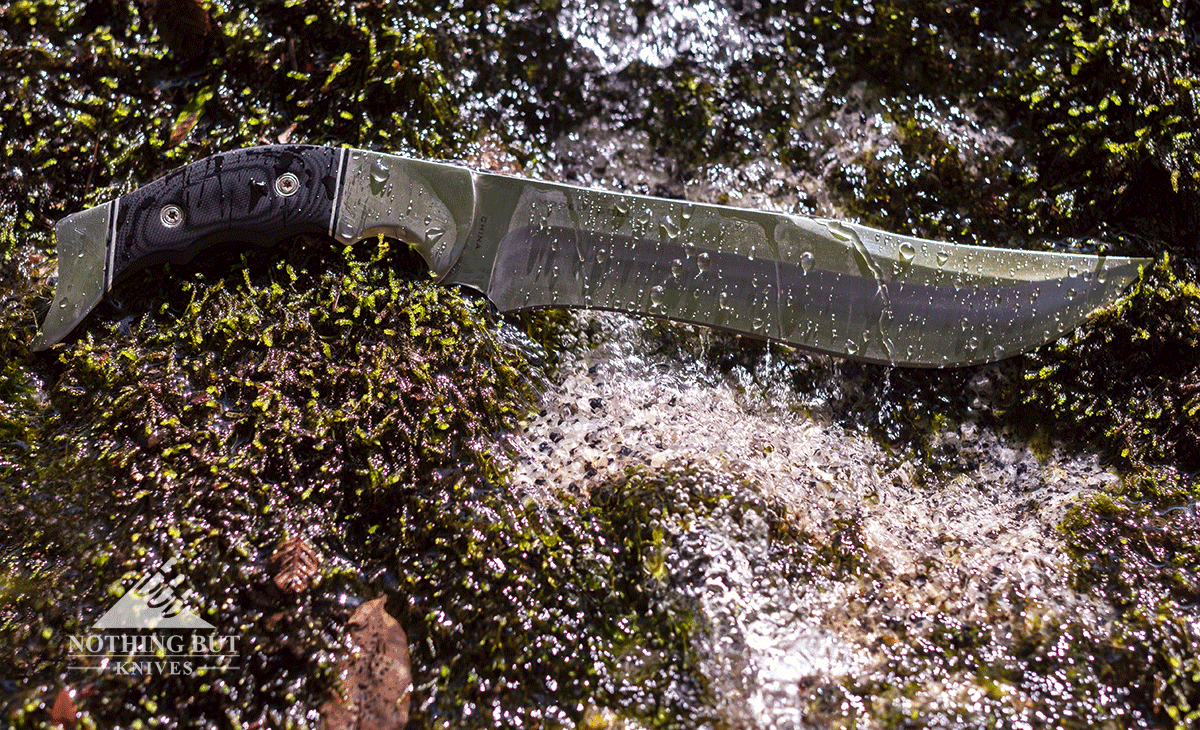
This knife is made for swinging, which means it excels in two categories: trail clearing and, as much as I hate to even bring it up, combat.
It’s one of those things everyone likes to bring up with knives for some reason, but almost everyone is uniformly wrong when they say a knife would be good for fighting. No knife is good for fighting, because getting in knife fights is stupid in the first place.
But if you’re going to be in one anyway, the Battle Bowie wouldn’t be bad to have on your belt. It’s called the Battle Bowie for a reason, and aside from the over-shaped handle, the style reminds me a lot of some of the bolo machetes and larger knives I’ve seen people working with in martial arts like kali and Arnis escrima (although maybe not so much in modern Arnis).
Good for the Back Cut, Less Good for the Thrust
Part of what makes the Battle Bowie excel here is how easily the blade cuts through things, but it has a lot more to do with the way the handle works with your hand.
On a knife this size (which is essentially machete size), I have two big concerns:
- How well does the handle stay in my hand
- Is it well balanced
There are a couple other concerns with sharpness and how the shape lends itself to slicing vs. stabbing, but those are concerns with any kind of fighting knife. When the blade gets this long and has this much of a curve, I need something that feels good on the back cut because that’s how a lot of my important strikes are going in.
This is what makes the Battle Bowie an attractive knife for fighting. This blade wasn’t just made for swinging hard, it was made for swinging well, ie. when I swing one direction, it’s really easy (considering the size) to change the angle and swing it another direction.
That fluidity comes from a healthy combination of decent balance and a light blade, but I feel it the most from the curve of the handle. It gives me a lot of control over momentum. I can get that blade moving fast as it changes direction because forward momentum is so sensitive to the movement of my hand.
The handle is not optimized for stabbing though. The G10 scales and stainless steel bolsters without some kind of handguard make thrusting risky with this knife if you’re sloppy. It’s actually where my frustrations with the knife come from. If they had put in a little handgaurd instead of that stupid choil this would be safer on the thrust and it would be closer to a true bowie knife.
Usable Pommel butt and Imperfect Balance
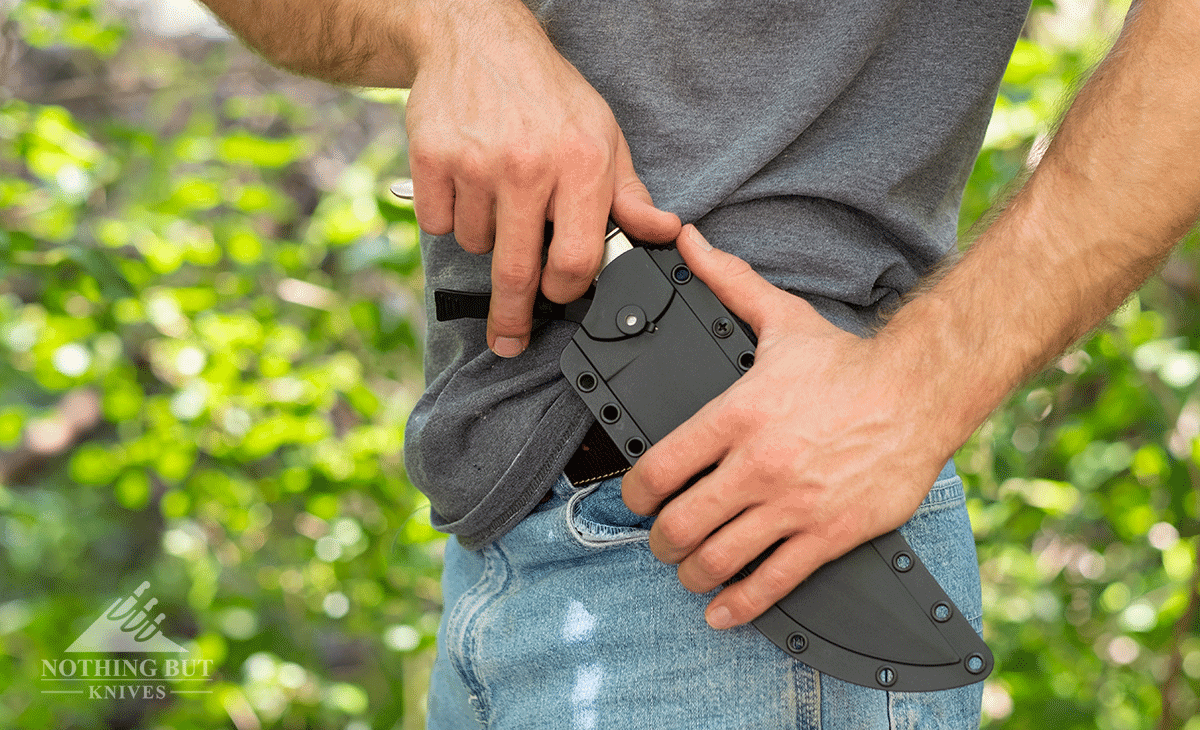
The balance sits just between that useless choil and the top of the handle. It’s not bad. The thing still feels good in the hand, but I’d rather have it either closer to where my index finger rests for better control or farther up on the blade so I know I’ve got a bit of lopping power.
The possible fix to this would actually build on one of the knife’s other strengths: the pommel.
The Battle Bowie’s pommel actually feels pretty nice to hammer with. It doesn’t come up that often, but having a good inch or two of aggressive pommel below your hand opens up a lot of options for non-lethal but potentially bone-breaking strikes. This pommel has a decent shape for striking, and if they just padded it with a little more steel it would bring the balance point closer to the index finger and the pommel would get a little scarier.
As it is, I can make it work
Limited Uses
The tactical stuff is out of the way now, and hopefully I never have to talk about that again.
Except for this: the Battle Bowie kind of forces itself into the category of a fighting blade. My brother and I had a long discussion about what you could use the Battle Bowie for (skinning, batoning, trail clearing, etc.) against what we would use it for… which isn’t much. We have a lot of bushcraft and survival knives that do a lot of things better than this bowie knife.
It opts itself out of some survival work with the useless choil which isn’t quite sharp enough to work a ferrot rod on, and the size is too awkward to start a fire with anyway. Plus it sits too far forward for me to comfortably choke the blade so the only way to hold this thing is in full traditional grip.
The Intention: Hunting or Combat?
The designer of the knife is Russ Kommer, who’s mostly making stuff for CRKT now. He’s a hunting and fishing guide who generally designs knives and tools with hunting in mind. His goal is to make sharp knives that are comfortable, and most of his earlier work (like the Battle Bowie) seems to be geared toward big game.
I am not a big game hunter. I haven’t skinned bear or moose at all much less with the Battle Bowie, and if I went bear hunting, I probably wouldn’t take the Battle Bowie along to skin the bears, I would take it to fight the bears.
But I’m not sure skinning was actually what Kommer had in mind for this design anyway. The name and the shape of the handle just don’t seem to lean that way. I think he had two things in mind when designing the Battle Bowie: swinging from one ship mast to the other so he could get to the zombie pirate captain at the helm and cut off his head, and clearing a trail.
As a trail Blazer
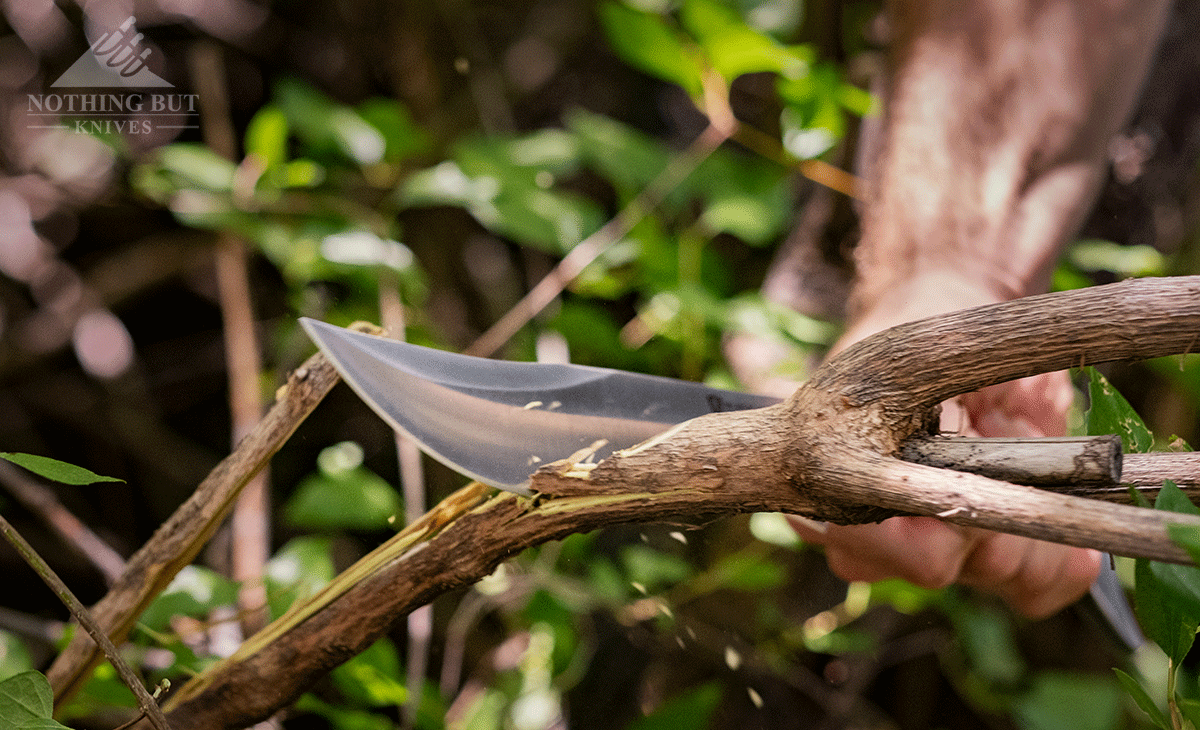
We’ve reviewed a couple different good chopping blades:
The Black Bear Bowie works well enough by virtue of its length and weight.
The Condor Stratos is thick, absurdly tough, but pretty much only good for chopping.
The Battle Bowie is terrifyingly effective and fun.
Holding this knife makes me ten years old again, and suddenly every hanging branch in the vicinity is in danger of getting cut up, because it swings and cuts so easily it becomes addicting.
Most trail clearing knives tend to be unwieldy and off balance when they’re in the price range of the Battle Bowie. They also tend to get most of their cutting power from the weight in the blade (like the Black Bear Bowie). There’s actually a decent balance to this Bowie, though, and when you swing, its shape kind of swings into your hand so it doesn’t feel like you have to keep tightening your grip just to keep it from flying away.
More importantly, the blade does an incredible job of cutting at speed. Anything with a 1-inch diameter or less only took one swing to get cleared out of the way. That’s what makes it really attractive as a trail blazer. It’s not that it can chop up big stuff (it definitely can do that, though), it’s that it cuts away the smaller stuff really fast.
The Handle is Good but Could be Better
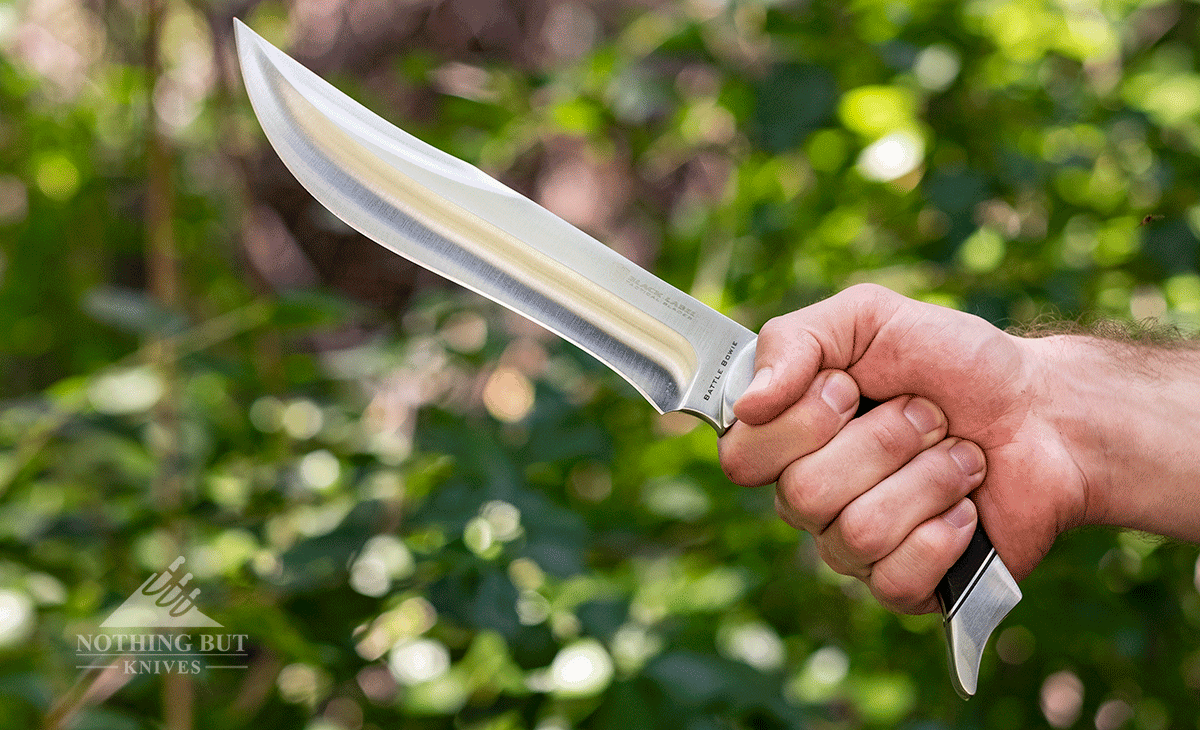
As much as I’ve come to like the look and feel of the handle, there are a couple small things I need to pick on.
- It’s a little too thin
- The material isn’t very grippy
The Browning Battle Bowie manages to be unusually comfortable and secure in hand, but that comes almost entirely from its shape alone. The G10 isn’t textured at all and it’s surrounded by stainless steel, which would be a pretty slippery combination if Kommer hadn’t designed the handle the way he did. But even with the rounded design it still digs into the hand a little bit because of how thin that handle is. I don’t notice while I’m cutting with it, but it gets jarring after a while.
It doesn’t exactly interfere with the performance. This is a good handle with some innovative thought behind it. I just can’t help thinking how much better the grip would be if the handle were a little wider and rounder so it curved more into the palm. I would even go so far as to suggest they put some kind of rubber inlay instead of G10, but maybe at that point it would be a different knife entirely. I’m just dreaming here, but at the very least it could use some texture.
Budget Steel and a Roughed Up Edge
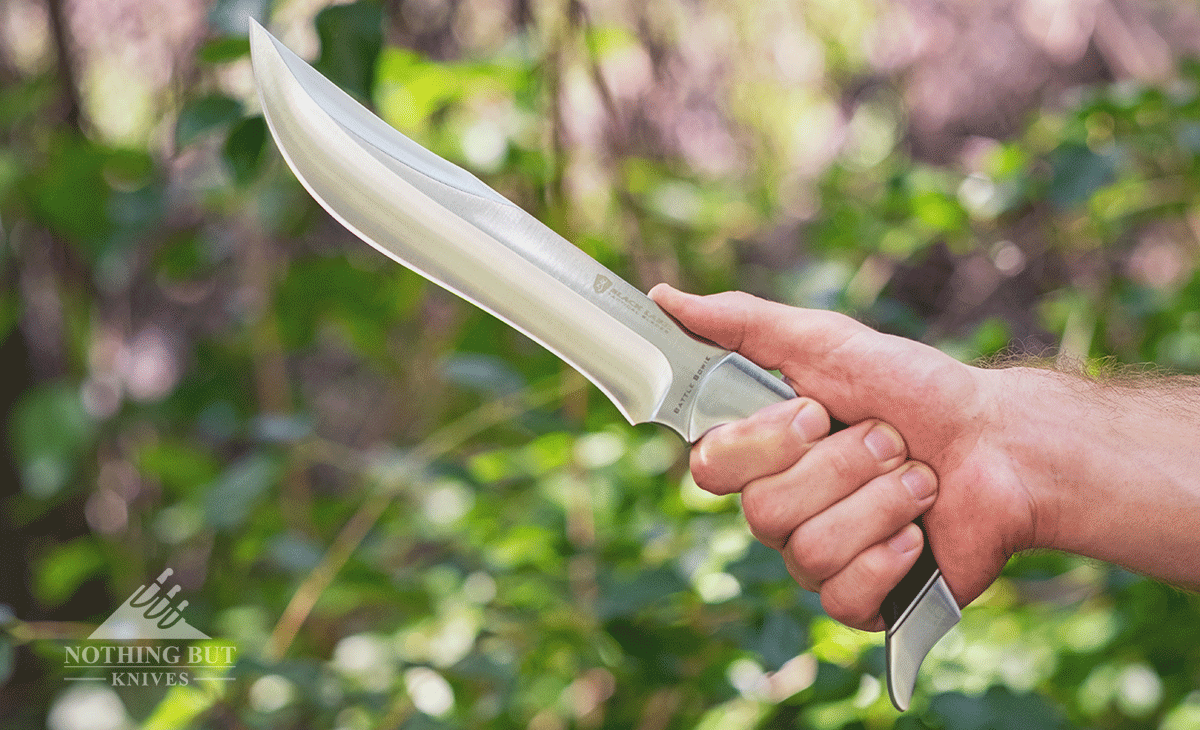
As long as we’re talking about materials, I guess we should talk about the blade.
I’ve found this knife listed with a couple different steels, so I’m not actually sure what steel I’m reviewing when I say this stuff is great so long as you don’t use it on anything harder than wood.
If you get the Battle Bowie with carbon fiber scales, you’re probably getting some kind of 5Cr steel, which runs around 56 – 57HRC. That’s a pretty common steel in bigger blades like machetes. The G10 version gets listed with either 8Cr13MoV or a 440 steel without a specified grade (although I suspect it’s 440A). Browning isn’t any help either since they don’t seem to have it listed officially on their site anymore.
Whatever the G10 version has, it’s good for this size of knife. Most of the brush and branches I’ve used it on have been different species of oak, willow, and probably mulberry. Then just for good measure I hacked into a couple branches off of a citrus tree at home for a while.
The edge has held up okay. I’ve honed it a few times, and I suspect I’ll need to sharpen it before too long if I keep using it heavily. One of the really impressive things about the knife though is that a lot of the ease behind the cut is because of the shape and grind of the blade, not just the sharpness. Even as it dulls, you can still get decent cuts thanks to the thin blade and the recurve.
I can also unfortunately attest to its inability to handle rock or concrete. I never mean to test knives on these surfaces, but sometimes you’re clearing some vines away near a boulder on the creek, and other times you’re at home trying to get the damn thing to work with a ferrot rod while you’re sitting on a concrete patio.
These are both recipes for a couple notches in the blade. But so long as you aren’t trying to crack rocks with it, the steel will hold up fine.
Multiple Carry Options
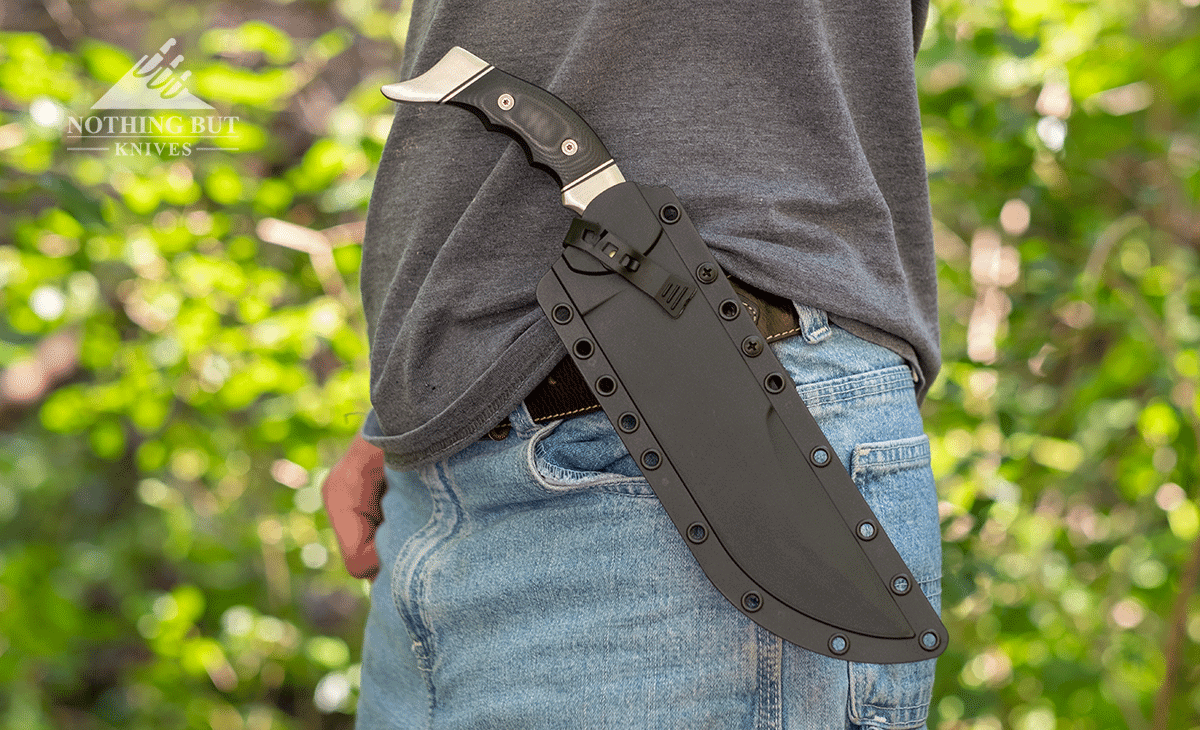
Even if the knife itself weren’t as useful as it turned out to be, the sheath itself brings a lot of its own value. The molded polymer is tough. This isn’t a cheap mold they just threw in with the knife. It has good retention and a solid structure.
The real appeal is the Tek-Lok it comes with. Whether or not you care to try this as a horizontal carry, the Tek-Lok makes this big knife a lot more secure on the belt than it would have been if they’d just slapped a big clip or strap on it. Because of that, the Battle Bowie actually works in scout carry really well.
It does present its own set of problems just by virtue of being so long, though. For me, one end always ends up sticking out beyond my side, which makes hiking tricky. Either the tip of the sheath or the pommel will definitely catch on stuff in thick brush and hold me back. It also weighed the belt down quite a bit, so unless your belt and pants fit well, this is going to sag back a little.
These are mostly problems for small-framed people though. The balance is even enough that the weight doesn’t carry awkwardly, and it actually feels a lot nicer to pull the knife from the small of your back than vertically from the side. If your belt can handle the weight, I would recommend carrying the Battle Bowie scout style. Otherwise, it works fine on the hip, but the weight and size will make you feel a bit lopsided until you get used to it.
Knife Comparison
We talk about a few viable alternatives in our bowie knives under $50 blog, but there are a couple specific points I need to make about this thing.
First of all, we tested the G-10 version which is at least half as much as the carbon fiber version of the Battle Bowie. So when we talk price, we’re working in the $50 range. Also the Battle Bowie does not fit easily into the Bowie knife category. There’s no hand guard, and it has a trailing point instead of a clip point. I think the reason it can justify its name is because it seems to be designed equally for trail blazing and fighting.
With that in mind, the Ontario SP10 Raider Bowie seems to present the biggest competition for the Battle Bowie. Not only is Ontario Knife Company pretty solid in terms of manufacturing practices, they use crazy tough materials like a Kraton handle and 1095 carbon steel. On paper, the SP 10 comes out looking great. In hand, things will be a little different. Just on blade-to-handle ratio alone you can tell the Battle Bowie will have a more even balance, plus the blade is thinner with a hollow grind instead of the Raider Bowie’s flat grind
In every aspect the Battle Bowie is built toward high velocity cutting. It does that so well, that I’m inclined to call it more of a short machete than a true bowie knife. There are bowie knives that are better than this one. The SP 10 and even the Buck 102 Woodsman are probably better as all purpose survival blades. But they won’t swing and slice like the Battle Bowie.
Conclusion: Get this Knife, but Get it for the Right Reasons
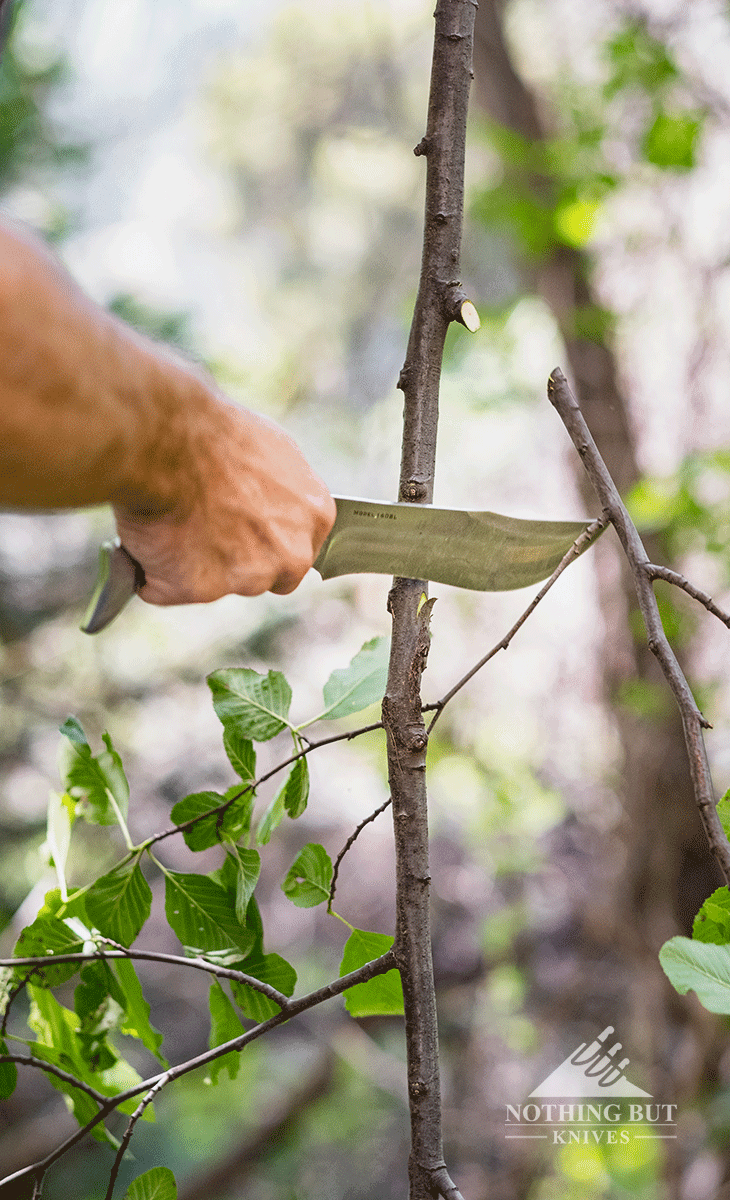
There are a couple ways you could justify buying this knife:
- It’s great for trail clearing and you can carry it horizontally,
- It’s better than your average survival knife for self defense,
- It’s probably okay for skinning large game.
For serious survivalists and big game hunters, I wouldn’t just recommend this knife; I would go so far as to recommend the slightly more expensive carbon fiber version with 5cr steel since the edge on that is a lot more likely to just roll instead of chip if it comes in contact with rock or bone. For the rest of us, the people who probably look at the Battle Bowie and see a toy rather than a tool, get it because it makes trail clearing fun.
You will use this knife if you’re just camping or hiking, but not because you need it over any of your other knives. What makes the Battle Bowie more attractive than, for example, one of the larger ESEE knives is that it lends itself to something a little beyond practicality. Sometimes it’s more about the swing of the knife itself than then thing you’re swinging at.
If you’re willing to admit that to yourself for a minute, the Battle Bowie is easily worth the $50.
